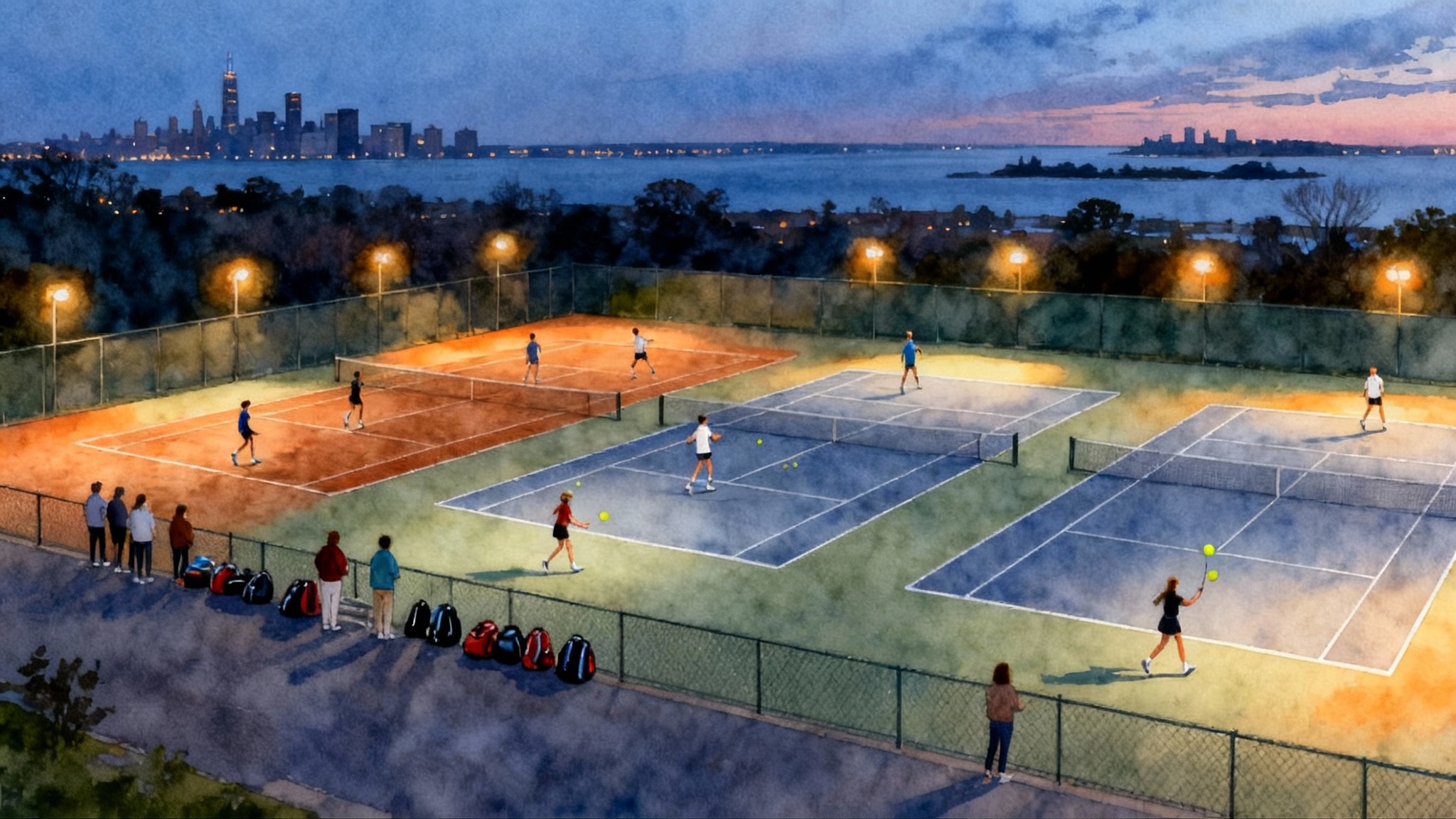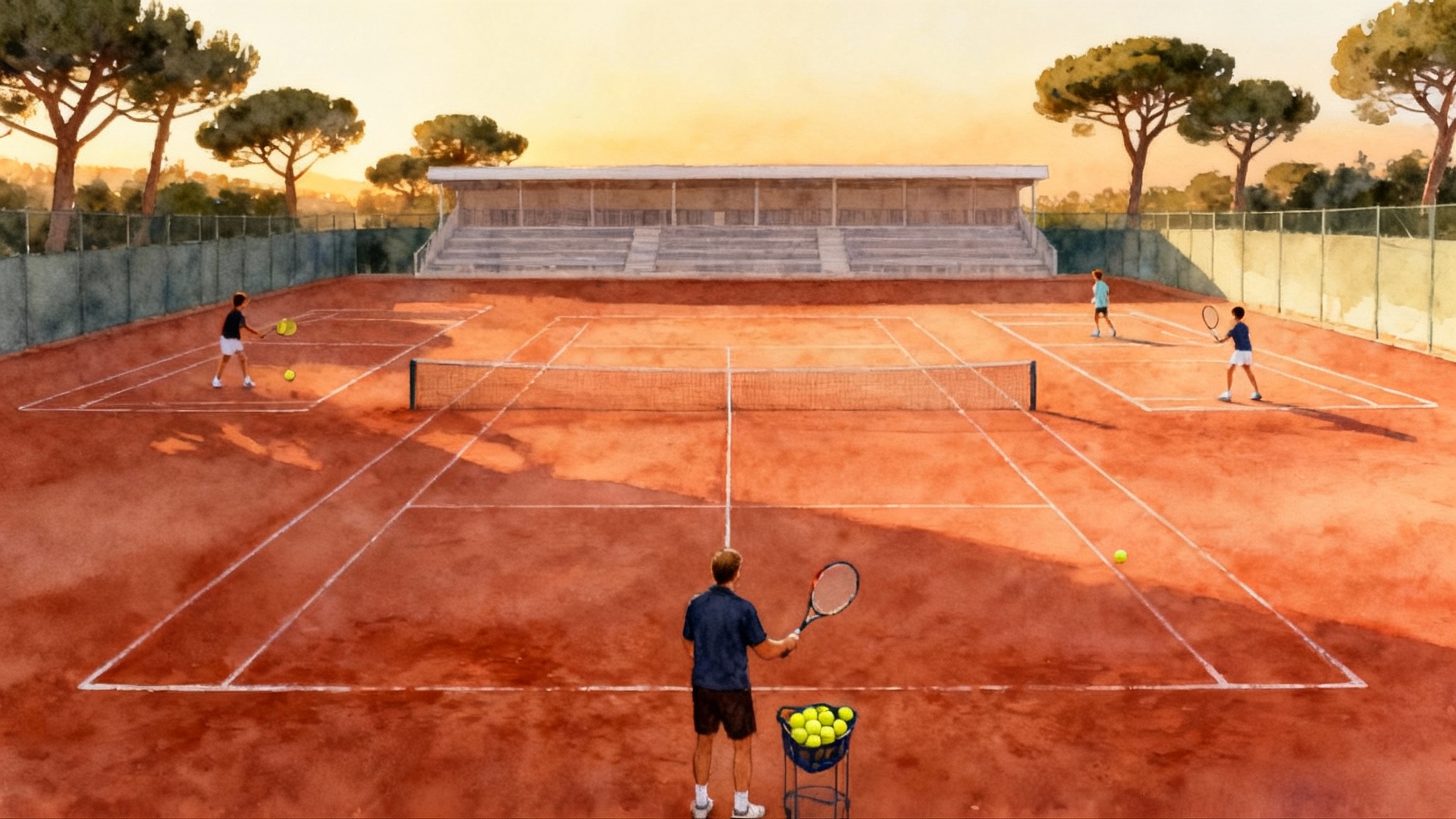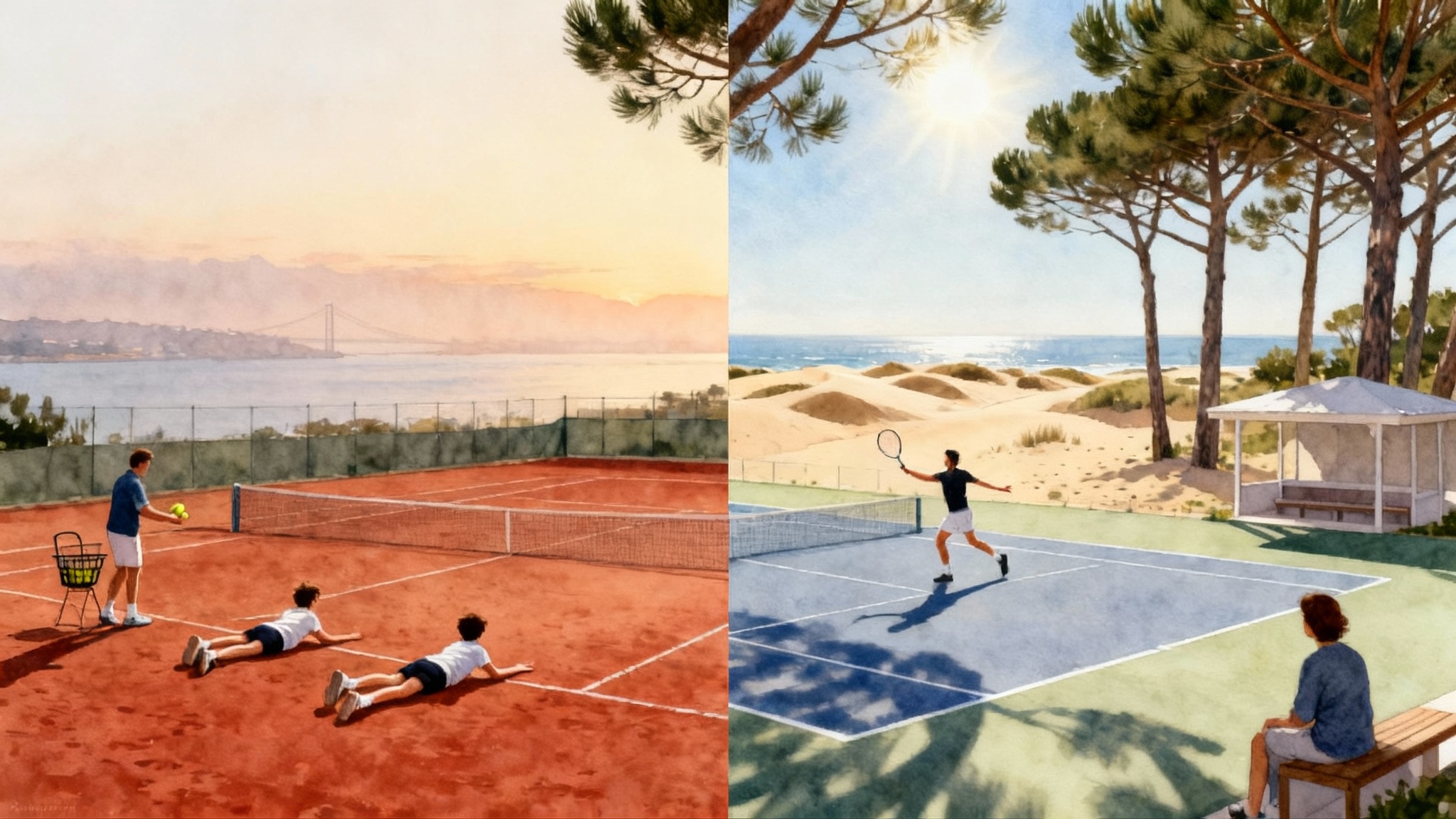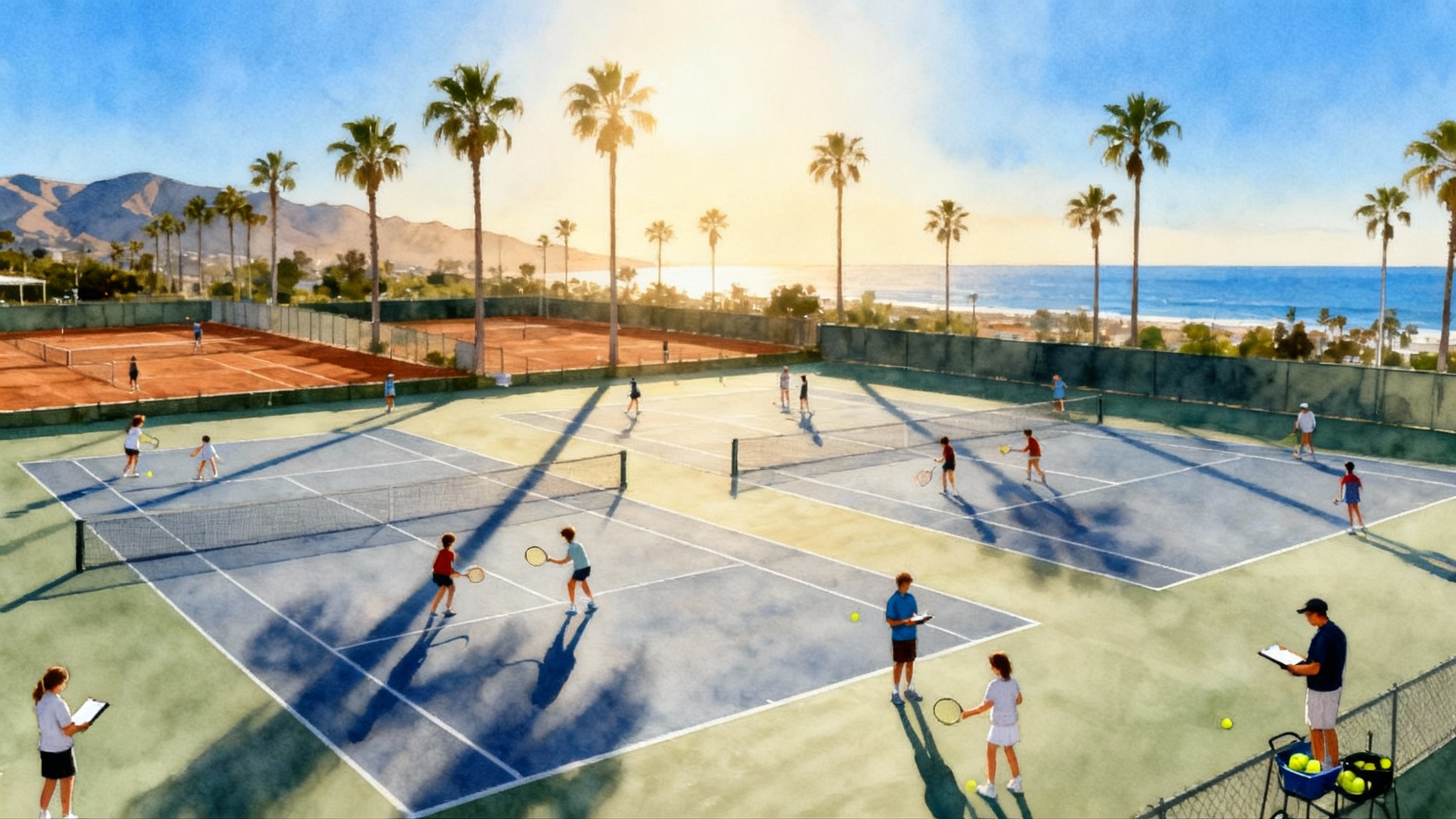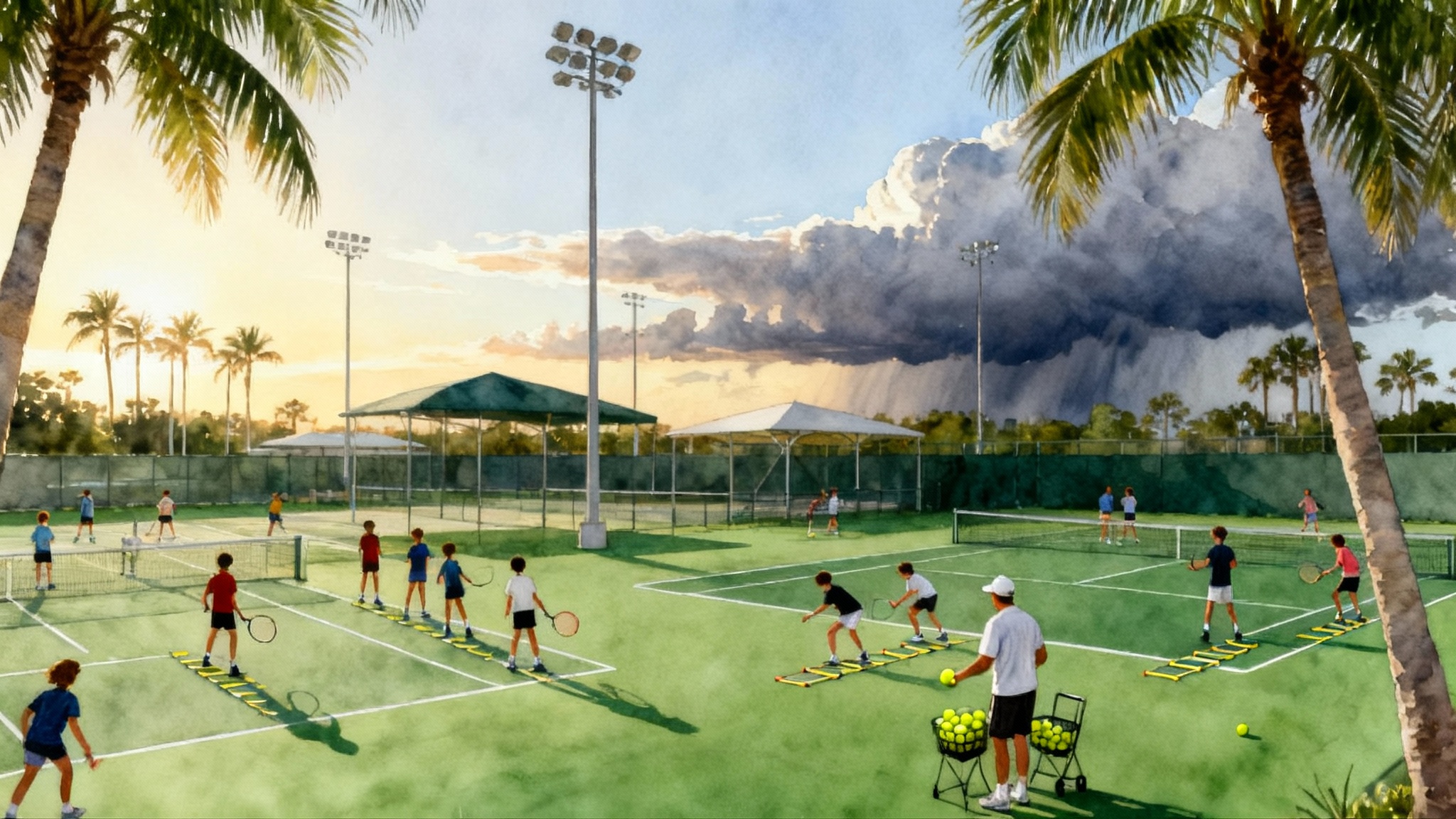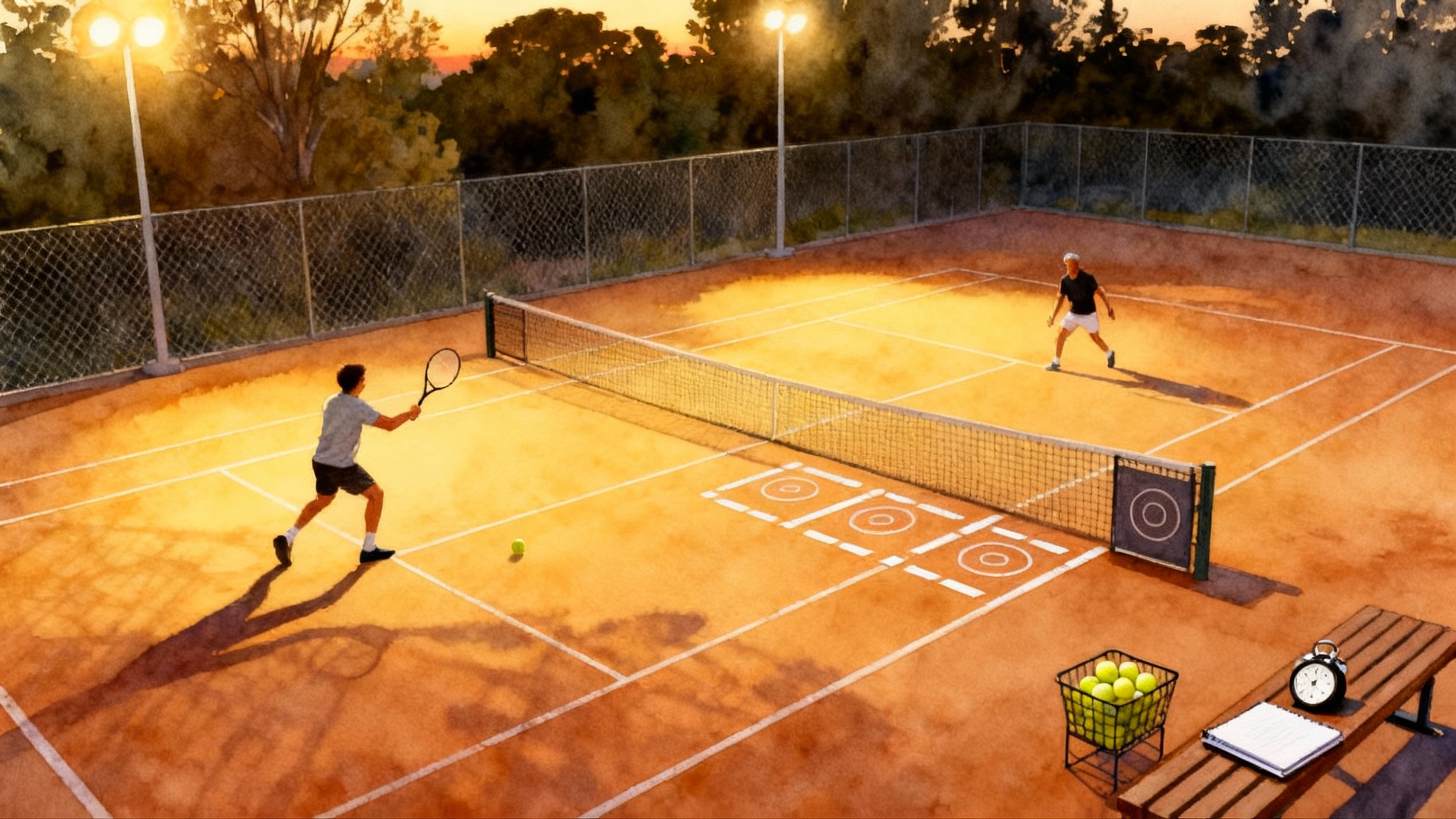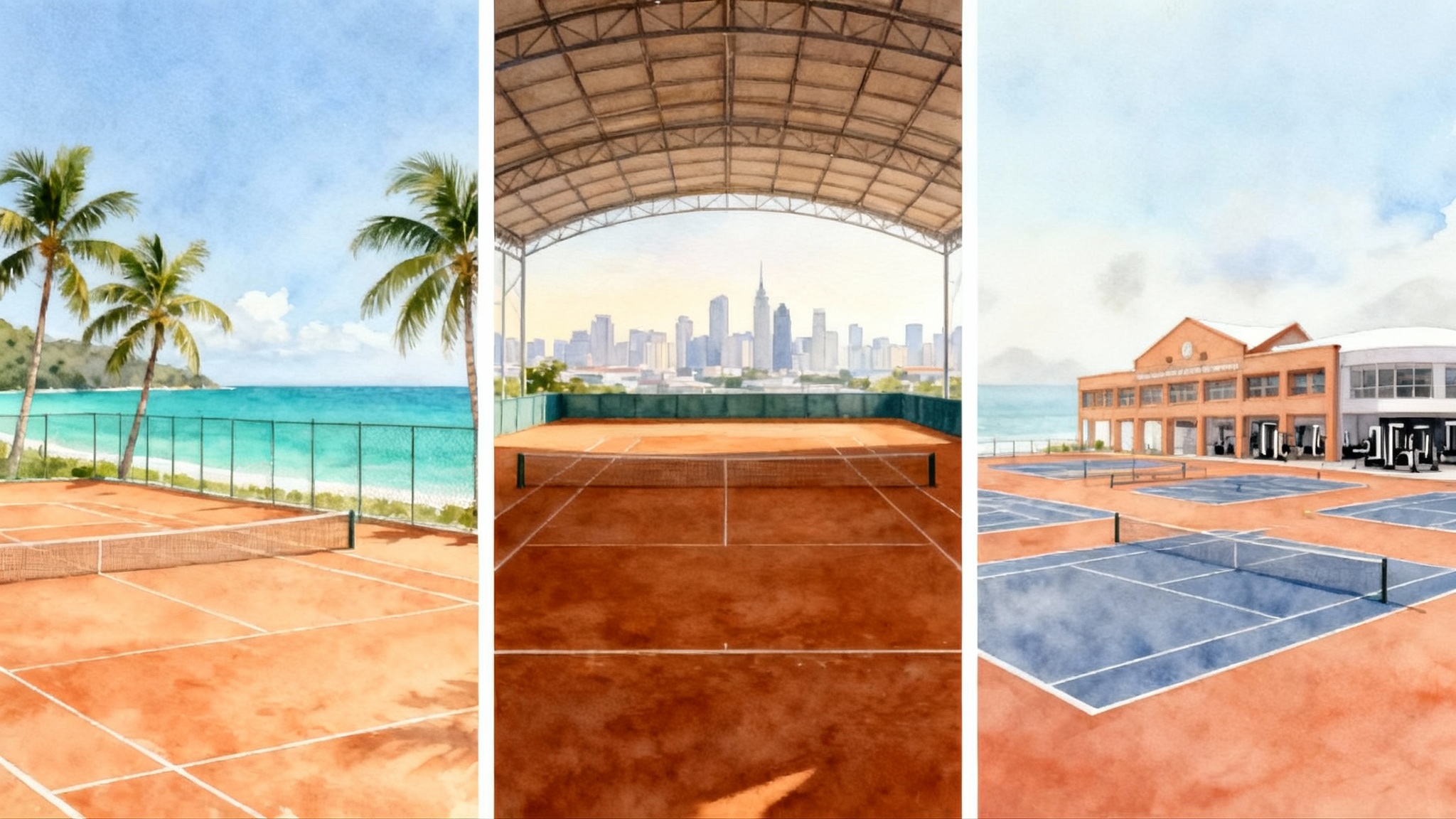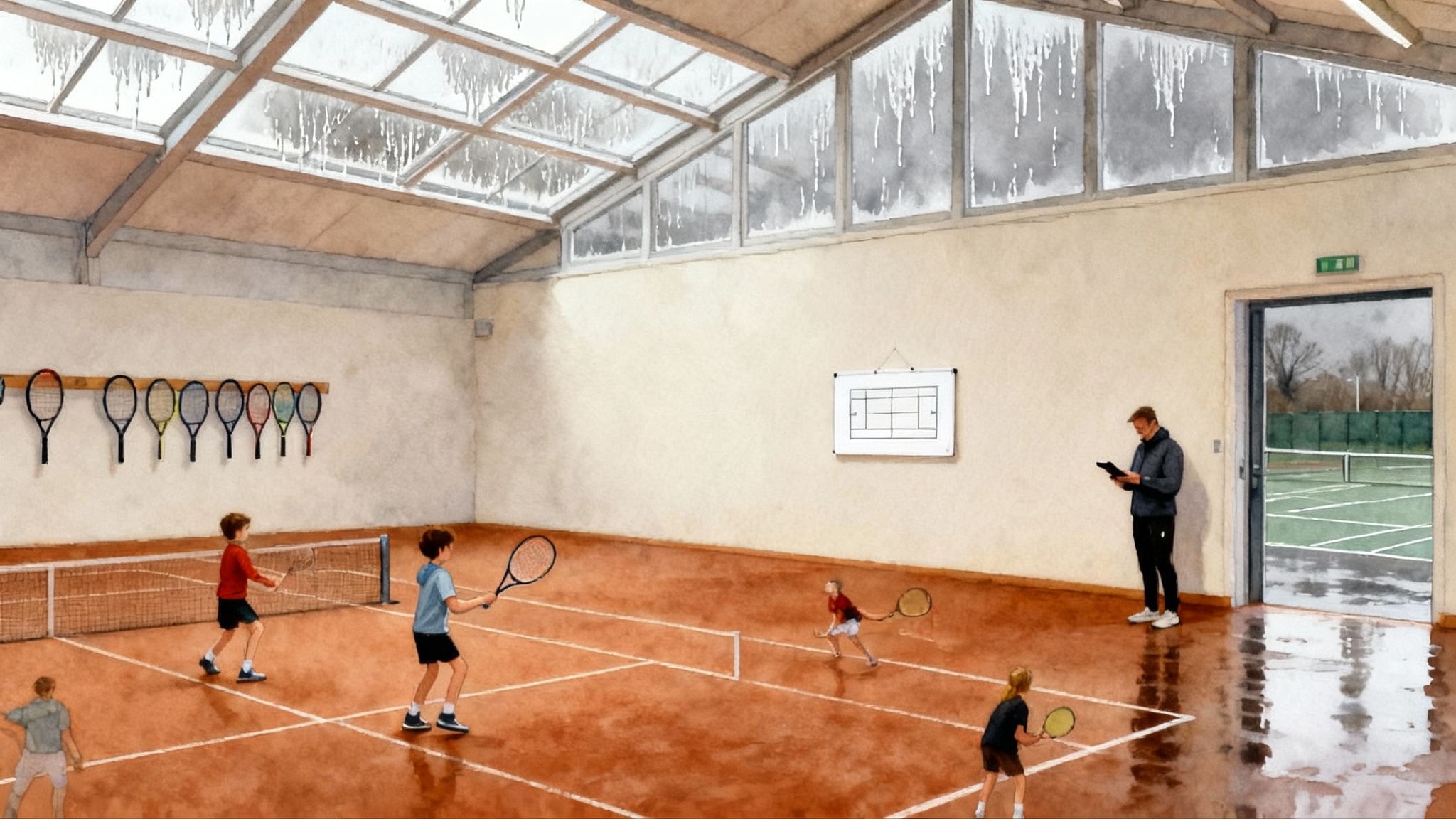Best Texas Tennis Academies 2025-2026: DFW, Austin, Houston
A practical, data-driven guide to Texas junior tennis for 2025-2026. Compare facilities, indoor access, clay vs hard, weekly training loads, coaching ratios, costs, boarding options, and UTR/WTN progression across Dallas, Austin, and Houston.
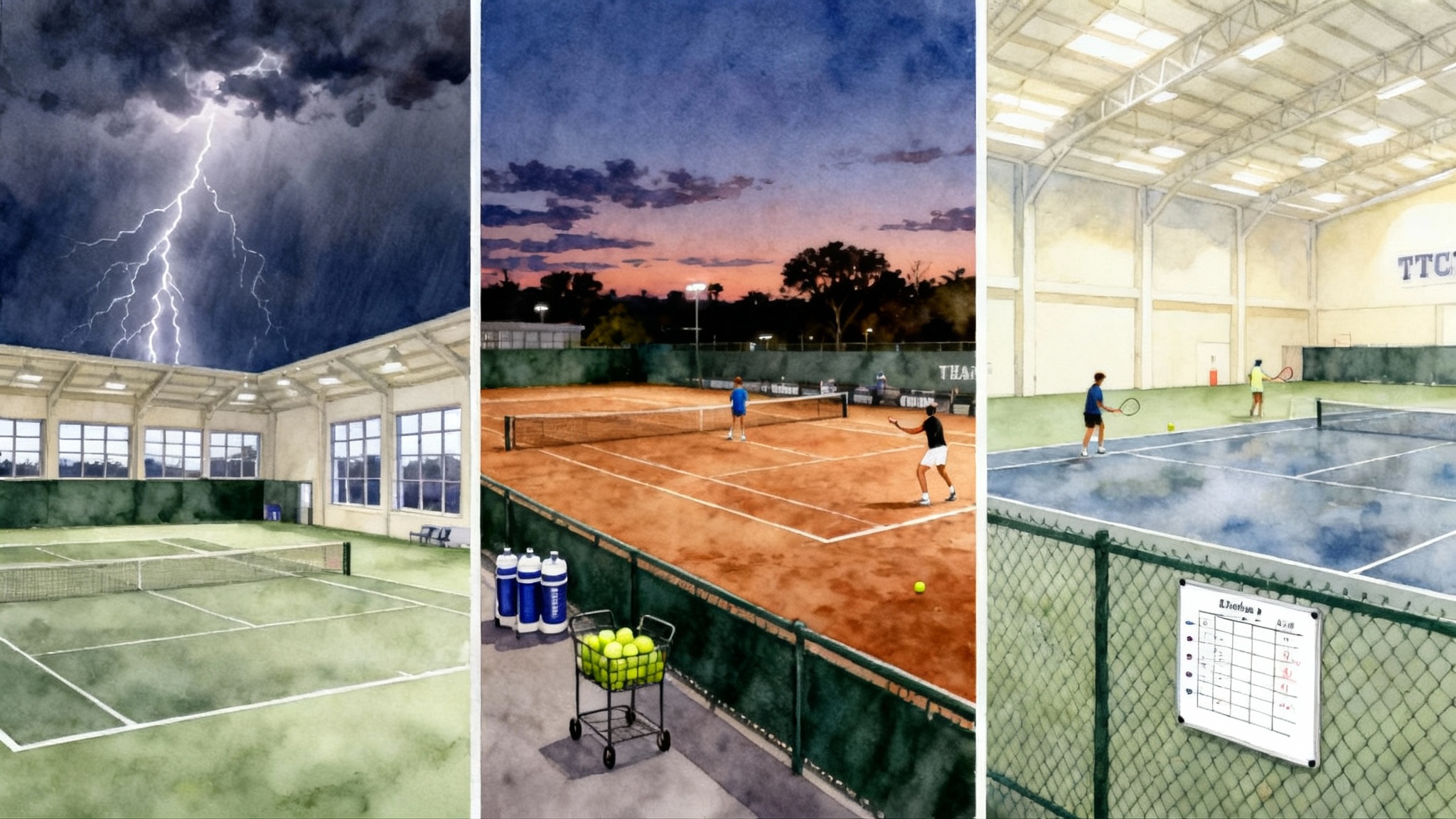
How to use this guide
Families choose academies for different reasons. In Texas, three variables dominate the decision: heat and weather, tournament access, and the quality of a junior pathway from red ball to college-ready match play. In this guide we compare Dallas Fort Worth, Austin, and Houston programs with the same yardstick:
- Junior pathway structure by ball color and competitive level
- Indoor or covered court access for heat and rain
- Clay versus hard court mix
- Weekly training loads and add on fitness
- Coaching ratios and staff depth
- Transparent costs and what is included
- Boarding versus commuter options
- Universal Tennis Rating and World Tennis Number progression with tournament travel
Where possible, we cite published schedules and pricing. If an academy lists pricing only after a trial or evaluation, we label it as by inquiry only. To cross check details and seasonal changes, see the DFW Tennis Academy profile and T Bar M Academy details. If you are comparing states, review our Florida junior academies guide.
Texas climate and surfaces in one minute
- Dallas Fort Worth offers the broadest mix of indoor courts in Texas. That matters in July and August and during winter rain.
- Austin skews outdoor. You get some of the state’s best hill country training environments with limited indoor relief, but there is real access to clay at select sites.
- Houston has the most consistent indoor options for juniors thanks to dedicated indoor clubs and shared facilities at large clubs.
Translation for families: If your player wilts in heat or you need weather proof consistency on school days, prioritize programs with truly indoor courts, not just shade pavilions.
Side by side: DFW Tennis Academy (Fort Worth) vs T Bar M Tennis Academy (Dallas)
Below is the comparison most families asked us for this year. One is a campus adjacent commuter academy that runs at a major collegiate facility; the other is a private club with a deep junior ladder and a full time option.
Facilities and surfaces
-
DFW Tennis Academy, Fort Worth
- Trains at the Bayard H. Friedman Tennis Center on the Texas Christian University campus. Facility has 27 courts, including 5 indoor courts and recessed outdoor match courts that cut wind and glare. Public hours and booking policies apply to non varsity courts. Surfaces are acrylic hard courts. For hours, indoor count, and fees, see the Bayard H. Friedman facility facts.
- Clay: none in daily rotation.
-
T Bar M Tennis Academy, Dallas
- Private club environment with a published 28 court mix: 8 indoor climate controlled courts, 6 Har Tru clay courts, and 14 lighted hard courts. That indoor count is a heat management advantage from May through September. Court mix and staffing are listed on T Bar M court mix and staff.
- Clay: yes, regular access for juniors in certain blocks.
What this means in practice: A Dallas or Fort Worth family that wants year round consistency will feel fewer cancellations and less reshuffling at these two programs than at typical outdoor only sites.
Junior pathway and weekly training load
-
DFW Tennis Academy
- Pathway: Tadpoles and Tiny Toads for beginners, a two hour Academy block for competitive players, plus supervised weekend match play when scheduled.
- Typical weekly load: Academy meets Monday to Thursday 5:00 to 7:00 p.m. A four day week gives 8 hours on court; add supervised match play on Saturdays for 2 more hours when offered. Fitness is integrated in the Academy block.
-
T Bar M Tennis Academy
- Pathway: Future Stars and red, orange, green ball for 10 and under, Launch for transition to yellow ball, Academy for tournament players, and a Full Time Academy during the school year with on site academics support.
- Typical weekly load for after school Academy: Monday to Thursday 4:30 to 7:00 p.m. plus Friday 4:30 to 6:00 p.m., or about 11.5 hours per week. Full Time Academy model often runs morning on court, mid day academics, afternoon on court and fitness.
Takeaway: T Bar M’s after school Academy yields more structured hours per week than DFW’s standard schedule. DFW’s schedule is efficient for commuters who build in tournament weekends and do not want daily late returns.
Coaching model and ratios
-
DFW Tennis Academy
- Small group, live ball heavy Academy environment. Staff emphasize real time feedback and weekend match play coaching. Published ratios vary by session and enrollment. Families report 6 to 8 players per court in peak season and smaller groups when school and tournament schedules thin the courts.
-
T Bar M Tennis Academy
- Large staff with United States Professional Tennis Association credentials and division by level within Academy. The club publishes individualized development plans, quarterly checkpoints, and video analysis at Academy tiers. Ratios vary by block; families typically observe 4 to 6 players per court in high performance segments and higher numbers in entry pathways.
What to look for: ask for a written weekly plan that includes coaches on each court, ball color, fitness minutes, and the specific tactical theme for the day. Shadow a session before enrolling.
Costs and what is included
-
DFW Tennis Academy
- Transparent session pricing is posted and can be purchased daily, weekly unlimited, block, or semester. Representative example observed in 2025: daily Academy around 50 dollars, weekly unlimited around 180 dollars, semester around 2,700 dollars. Supervised match play blocks are typically added separately. Families appreciate pay for the week you use flexibility.
-
T Bar M Tennis Academy
- Academy serves both members and non members. Pricing is by inquiry after placement and can differ for members versus non members. Expect higher total cost than municipal academies, in exchange for indoor access, staffing depth, and full time pathway support. Full Time Academy is quoted after evaluation and academic plan review.
Budget lens: If you want predictable monthly spend and you do not need a full time school solution, DFW Tennis Academy’s published session menu is easier to forecast. If you want an integrated multi hour weekly load with frequent indoor access and potential college advisory, plan on a higher but more bundled spend at T Bar M.
Boarding versus commuter
- DFW Tennis Academy: commuter only.
- T Bar M Tennis Academy: day academy only; Full Time Academy integrates academics but does not operate dorms. Families relocating for tennis rent nearby.
If you need boarding in North Texas, look farther afield or consider Houston options listed below.
Tournament travel, UTR and WTN progression
Two rating systems matter in Texas: Universal Tennis Rating, a global 1.0 to 16.0 scale that updates from verified and some unverified results, and World Tennis Number, the International Tennis Federation scale used by the United States Tennis Association. Both reward frequent, competitive matches over narrow win loss focus.
- DFW Tennis Academy builds weekend supervised match play into the calendar and encourages USTA Texas and UTR events across Fort Worth and Dallas. Training at the Texas Christian University facility also means regular exposure to college tennis energy and occasional collegiate events on site.
- T Bar M runs in house UTR events and fields large teams in Dallas league play. Families use the Academy week for skill acquisition then stack tournaments two weekends per month during the school year.
Progression rule of thumb: in grades 7 to 10, target one true match day per week on average across the year. That can be a UTR event, a Level 6 or Level 5 USTA tournament day, or structured in house match play with verified scores.
Best fit by player profile
- Choose DFW Tennis Academy if your player is a commuter who wants consistent two hour weekday blocks, reliable indoor fallback during rain or heat, and an a la carte budget with clear week by week costs.
- Choose T Bar M if your player needs more weekly volume, benefits from frequent indoor training and clay exposure, and you want a club ecosystem that can support a full time academic athletic schedule in high school.
Austin benchmarks
Austin offers two distinct strengths: a serious high performance culture and access to clay alongside hard courts. Indoor access is limited, so summer schedules often shift toward mornings.
-
Austin Tennis Academy (Spanish Oaks)
- Facilities: 12 hard courts plus 2 Italian red clay, a 3,200 square foot fitness center, pro shop, and dedicated classrooms. Outdoor lighting extends evening play. No indoor tennis courts.
- Pathway: Junior Development and Academy streams with a four day after school model that includes daily fitness blocks. Full time academic options on campus allow a day training schedule in school months. Private lesson rates are published by coach experience and typically range from about 70 to 170 dollars per hour.
- Weekly load: common after school block is about 2.5 hours per day, four days per week, with periodic Saturday practices and summer blocks most weekdays.
- Costs: Academy tuition is by inquiry. Private lesson pricing is public. Expect a higher total investment if you add regular one to one time.
- Best for: serious tournament players who want clay in the mix and can handle outdoor first summers. College focused families like the on site academic integration.
-
Polo Tennis and Fitness Club High Performance (Bee Cave)
- Facilities: 10 Plexi cushion hard courts with subsurface cushioning for joint protection, plus fitness center and pool. Clay is not the focus here. The club partners with AESA Prep Academy for flexible academics.
- Pathway: beginner to elite with a published high performance track. Scholarships and occasional housing support exist, subject to evaluation.
- Costs: by inquiry. Expect club dues for certain options.
- Best for: all hard court training with a cushioning system that helps heavy trainers reduce joint load, and families seeking flexible academics nearby.
Austin decision tip: if your player aims for college tennis and can practice outdoors most of the year, Austin Tennis Academy’s clay plus hard mix builds point construction and footwork variety. If your player has a history of shin or knee irritation, the cushioned hard at Polo can be a practical compromise.
Houston benchmarks
Houston’s headline is weather control. Multiple programs train indoors at least part of the week, which keeps school night schedules intact even during summer storms.
-
King Daddy Sports at Chancellors Family Center
- Facilities: fully indoor tennis training environment during the school year and summer camps, which is rare in Texas.
- Pathway and loads: clear ladder from 10 and under to High Performance for players with a Universal Tennis Rating around 3 and above. Typical High Performance block runs Monday to Thursday roughly 4:30 to 7:00 p.m., with match play add ons.
- Costs: among the most transparent in the state. Published monthly or per session pricing enables precise budgeting. Expect multi day discounts and separate fees for camps and match play.
- Best for: families who demand heat proof consistency and value clear tuition menus.
-
Houston Tennis Academy at Club Westside
- Facilities: large private club with 22 outdoor and 4 indoor courts. Indoor access smooths out summer and rain days.
- Pathway: QuickStart for ages 5 to 10, Challenger for Level 6 or 7, and an upper tier group for Level 5 and better. Speed and agility blocks are integrated before some practices.
- Costs: published monthly pricing for each tier; Club Westside membership required. Transparent and predictable.
- Best for: multi sport club families who still want indoor backup and a structured rating based ladder.
-
Giammalva Elite Tennis Academy
- Facilities: 20 outdoor courts with one clay court, full fitness and gym.
- Pathway and ratios: Elite sessions publish a 4 to 1 player to coach ratio for drill blocks, then fitness and match play. Saturday add ons are common.
- Boarding and academics: boarding is available for out of area players; academic support offered through an AESA Prep partnership.
- Costs: priced in four week sessions with clear add on rates for extra drill days and Saturday blocks.
- Best for: out of town Texas players needing boarding without leaving the state, or Houston families who want a small ratio elite block.
Houston decision tip: if your player’s match level jumps indoors and wilts outdoors, start at Chancellors or Club Westside. If you need boarding plus a defined elite ratio, Giammalva is the most turnkey.
Age, level, and college ambition: what fits where
-
8 to 10 and just starting
- Dallas area: T Bar M’s red and orange ball blocks hit frequency targets with abundant indoor fallback on storm days.
- Fort Worth: DFW Tennis Academy’s Tadpoles and Tiny Toads is a low commitment on ramp with easy scheduling.
- Austin: Austin Tennis Academy’s red to green progression plus access to real clay builds footwork and spin literacy early.
- Houston: King Daddy’s fully indoor 10 and under classes keep attendance consistent when summer heat would otherwise cancel.
-
11 to 13, first USTA tournaments
- Dallas: T Bar M Launch and Academy deliver roughly 10 to 12 weekly hours plus clay doses that encourage patient, pattern based play.
- Fort Worth: DFW’s four 2 hour Academy sessions are enough volume when paired with two tournament days per month.
- Austin: Austin Tennis Academy’s Academy plus one weekly private accelerates serve and return skills; clay days teach defense to offense transitions.
- Houston: King Daddy or Club Westside for indoor stability; Giammalva if you want small ratio elite reps.
-
14 to 18 chasing college rosters
- Dallas: T Bar M Full Time Academy is built for this cohort with morning and afternoon on court, plus academics support. Add clay blocks to round out point construction.
- Fort Worth: Train after school at DFW, then stack verified UTR events and Level 5 or better USTA tournaments. Use TCU’s indoor access to protect weekday volume in spring.
- Austin: Austin Tennis Academy’s full time school and training path is a proven route for college placement. Plan regular private lesson cycles and film analysis.
- Houston: Giammalva for small ratio elite work and boarding if needed, King Daddy for consistent indoor volume and frequent match play.
Surface and schedule strategy you can copy this week
- If your player competes mostly on hard courts, run two hard sessions and one clay session weekly from October to April to teach height, shape, and reset skills. In summer, keep at least one morning clay day to spare joints and train endurance at lower speeds.
- For heat, choose one indoor day early in the week for high intensity drilling, then an outdoor evening for serve targets and point construction. That mix preserves intensity without sacrificing heat adaptation for weekend tournaments.
- For UTR and WTN gains, favor verified matches against a mix of slightly stronger and closely matched opponents. One verified match day per week on average for 40 to 45 weeks outperforms binge and break cycles.
What to ask before you commit
Use these questions on your tour and in your trial lesson:
- How many total minutes of live ball versus feeding will my player see per session, and how does that change by day of the week?
- What is the default ratio on my player’s court during peak season, and how do you flex staff if attendance spikes?
- Which courts are climate controlled and how often will my player be scheduled there in June through August?
- How many clay hours per month will my player get, and on what tactical themes?
- What is the written progression from red to orange to green to yellow ball, and what match standards are required to move up?
- What is included in tuition, what is extra, and what is the typical monthly total for my level if I add one private lesson per week?
- How do you align practice themes with my player’s tournament calendar two weeks before and after events?
- How do you report on progress? Ask to see a sample quarterly report or video analysis for a masked player.
- For full time programs, who manages NCAA eligibility and transcripts, and how many graduates signed with college programs last year?
- If my player is injured, what is the return to play plan and which staff member coordinates it?
Bottom line: recommendations you can act on
- Fort Worth commuter with a tight budget and a busy school week: pick DFW Tennis Academy. You get reliable two hour weekday blocks, indoor fallback at a collegiate facility, and pay as you go simplicity. Plan two tournament weekends per month from September to May, and one in June and July.
- Dallas family seeking maximum weekly volume and college track support: pick T Bar M Academy. The indoor count and clay access protect training quality. If your player is rising into high school, ask about the Full Time Academy schedule and quarter by quarter planning.
- Austin family prioritizing clay and on site academics: pick Austin Tennis Academy. Add one weekly private lesson in the pre season, then maintain it bi weekly during tournament stretches.
- Houston family needing indoor reliability with transparent tuition: pick King Daddy at Chancellors or Houston Tennis Academy at Club Westside depending on your preferred club culture. If you need boarding or a published 4 to 1 elite ratio, pick Giammalva.
Choosing well comes down to matching your player’s daily environment to how they will actually compete. Surfaces teach specific skills, indoor access preserves volume, and verified match play moves the ratings needle. When those three line up, progress stops feeling like a mystery and starts feeling like a plan you can repeat.

